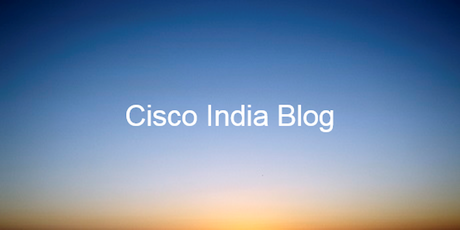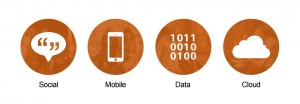
Key trends shaping SP market in 2016
Even as the year ended on a sobering note due to the devastation caused by rains and flooding in Chennai, we take heart in the incredible demonstration of kindness and humanity shown by Chennai citizens in helping each other through the ordeal. Technology was put to the best possible use, so relief efforts could be organized by providing a communication platform to disseminate updates about homes opened up to provide safe harbours, provisions for water and food, updates about loved ones, modes of help available, and much more. A real human network was created, enabled by technology and social media.
As we appreciate the benefits of technology in our lives today, the conclusion of the year is a good time to take stock. 2015 continued the trend for setting new milestones in every area of technology, and specifically those relevant to Cisco: continued proliferation of smart, IOE-enabled devices, consumerization of enterprise, digitization of business, and more. 2016 will see a continuation and enhancement of these trends with a growing impetus on the following:
Key trends that will dominate in 2016
- Convergence of IT and Mobile Applications
As end-user market segments become more diverse in their needs and requirements, they embrace a plethora of devices and platforms. Software and solutions that only run on PCs and networks are too limiting; today they need to access and leverage information sources across multiple platforms and devices. An application has to be versatile enough to run on a variety of access points – from traditional PCs to mobile devices with varying capabilities (smartphones, tablets, 2-in-1 hybrids, etc.).
Businesses are adopting “agility” as their watchword, and they’re eager to embrace solutions that can help them achieve their goals. As a result, a transformation is underway, heralding a convergence of IT and mobile applications. These new-age solutions need to be device agnostic, with interoperability across networks, and will help achieve organizational efficiencies and agility.
- Big Data and Analytics
Big data and analytics have emerged as technology buzzwords in recent years, yet the adoption of such solutions has been limited. Service providers in India will see an unprecedented rise in the volume of analytics information resulting from increasing smartphone usage, roll-out of high speed data networks (4G), and the rise of social media.
Additionally, e-commerce in India is increasingly being driven by smartphones adoption, with most transactions happening through mobile devices. Service providers who can leverage insights from the data they collect are in a better position to offer differentiated services, and a superior, personalized customer experience. They have opportunities to identify new revenue streams, better bundle their products and services, and increase their profitability. For telecom service providers, successfully harnessing big data can help achieve three critical business imperatives: deliver innovative services that generate new sources of revenue; transform and simplify operations to achieve business and service excellence; and build intelligent networks to drive a consistent, high quality customer experience.
The value of mining big data for market information and real time decision making is well established, and service providers in India are already handling unprecedented volumes of data. The challenge in 2016 will be in handling an ever-expanding network, and moving the intelligence gathering and processing to the edge of the network. A distributed system with localised analytics modules will allow a faster and more fine-tuned response that takes into account local preferences and nuances for the decision making process.
- Internet of Things
We will see Internet of Things (IoT) or rather the Internet of Everything (IoE) getting real. It will open up new business models and revenue streams for all players in the ecosystem – device makers, software companies, communications service providers, etc. The challenge will be to build applications that have real and immediate use cases and can be quickly adopted. There is a race to build solutions that leverage connectivity and data analytics in an ecosystem of varied and “chatty” interconnected objects, and todeliver intelligent automation that can be applied to our daily lives. The visionis for an IoE-based ecosystem that is self-sustaining with minimum human intervention.
Furthermore, the rise of the Internet of Things (IoT) will add to the deluge of data, structured and unstructured, thereby adding to the complexity of big data. In 2016 we expect to see a range of solutions to address the challenge of managing and making sense of this massive amount of data to produce actionable insights.
- Mobile money & Financial Inclusion
The time is right for mobile financial services to gather momentum, and I believe 2016 will see a mass adoption of mobile money in India. The ecosystem is ready. Smartphones have become affordable. Internet connectivity is improving. 4G services are being launched; payment-banking licenses are being issued. And most importantly, there has been thrust by the government and the Reserve Bank of India (RBI) on financial inclusion and services to the unbanked population.
The key is to have the right technology solution and the right channel partners to provide services that are intuitive and can be easily used by all, including people with little or no formal education. Services and solutions with a focus on usability and security will be the key.
Integrated mobile services that provide a one-stop shop for all our banking needs (payments, transfers, automated utility bill payments, loans, deposits, etc.) will have the greatest appeal. The banking industry is close to a complete transformation, enabled by mobile technology and innovative mobile wallet solutions, and we will see significant adoption and growth in this space.
- Network Functions Virtualization (NFVi)
NFVi is no less than a paradigm shift that will transform service providers’ networks from a predefined set of physical infrastructure components to a set of modular software building blocks. These building blocks can be created, combined and shuffled at will to create new network services, turning today’s static networks into dynamic, elastic network clouds.
Until now, high network equipment cost and operational complexity have hampered service providers in their battle against more nimble over-the-top (OTT) competitors who have set a high bar in terms of customer expectations for quick delivery of new services. The adoption of NFVi will help service providers meet this challenge. It will enable them to move from multiple proprietary devices to commercial off-the-shelf (COTS) servers, from physical network installation and configurations to remote, automated software-based processes to achieve automated elasticity and scaling. This will significantly improve business agility with the benefits of a faster time to market for new services, quicker revenue returns on existing services, removal of cost barriers in providing niche services, and the ability to leverage customers in a cost-effective manner to validate new services.
- Data Integrity & Security
The need for security continues – from the network level up to the device and data level. Service providers will have to stay vigilant and updated in their efforts to provide secure access without losing the flexibility that is so valued by consumers. They will have to manage the deluge of unstructured data and make sense out of it, if they are to be successful about securing private, confidential and high risk data. They also have to continue to harden their entire infrastructure, across all connectivity modes, so as not to be vulnerable to denial-of-service attacks.
These trends hold much promise and potential for the service provider industry. With a forward-thinking strategy and judicious investment, the industry stands to grow and capitalize on the many opportunities ushered in by these trends.
Tags:- analytics
- Asia Pacific
- big data
- broadband
- cable and satellite
- cable operators
- Digital Cable TV
- Digital India
- Digitization
- Innovation
- internet of things
- IT
- mobile applications
- network
- Network Function Virtualization
- security
- Service Provider
- Telcos
- Transformation
- Video on Demand
1 Comments




Route